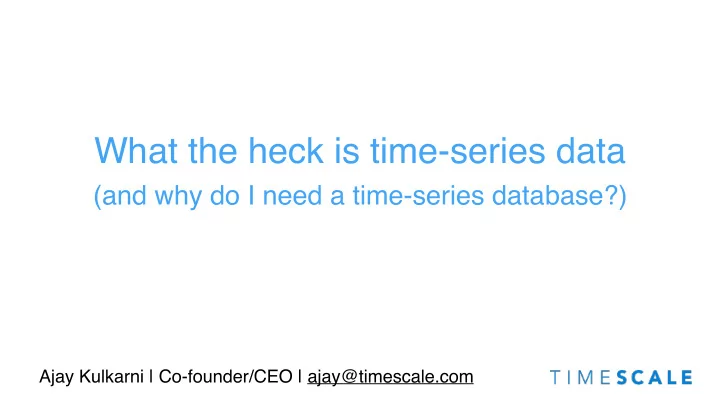

What the heck is time-series data (and why do I need a time-series database?) Ajay Kulkarni | Co-founder/CEO | ajay@timescale.com
Fastest growing database category Source: DB Engines
In this talk 1. What is time-series data? (hint: it’s not what you think) 2. Why do I need a time-series database ? 3. Is this just a fad?
What is time-series data ?
Q: Metrics and Logging? CPU, free memory, gc pauses, error reports, application instrumentation, etc. ✓
Q: Financial data? Stock tick stream, payment records, transaction records ✓
Q: Event data? Clickstreams, application events, outages, errors, system status ✓
Q: IoT data? Sensor data, machine data, industrial monitoring, smart home, wearables ✓
Q: Other data? Logistics tracking, environmental monitoring ✓
A: All of the above
So what is time-series data ?
Time-series data has 3 characteristics • Capturing and analyzing 1. Time-centric data measurements/events over time. • Workloads generally 2. Primarily write new data. Rarely INSERTS update. • Data generally written to 3. Writes to recent most recent time interval interval (although delays possible).
How is this different than having a time field? Treat changes as inserts, not overwrites.
You can do more with time-series data PAST PRESEN FUTURE T • Analyze historical trends. • Real-time monitoring • Identify and fix problems before they • Look at the state of the • Troubleshoot occur, reducing system at any point in problems as they downtime. time. occur
What does time-series data look like? (hint: it’s not what you think)
What you have been told Name CPU Tags Host=Name,Region=West Data 1990-01-01 01:02:00 70 1990-01-01 01:03:00 71 1990-01-01 01:04:00 72 1990-01-01 01:04:00 73 1990-01-01 01:04:00 100
What you have been told Name CPU FreeMem Tags Host=Name,Region=West Host=Name,Region=West Data 1990-01-01 01:02:00 70 1990-01-01 01:02:00 800M 1990-01-01 01:03:00 71 1990-01-01 01:03:00 600M 1990-01-01 01:04:00 72 1990-01-01 01:04:00 400M 1990-01-01 01:04:00 73 1990-01-01 01:04:00 200M 2 time-series? 1990-01-01 01:04:00 1990-01-01 01:04:00 0 100
This is wrong
Time-series data has a richer structure Tags Host=Name,Region=Wes t CPU MemFree Temp Data 70 800M 80 1990-01-01 01:02:00 71 600M 81 1990-01-01 01:03:00 72 400M 82 1990-01-01 01:04:00 73 200M 83 1990-01-01 01:04:00 100 0 120 1990-01-01 01:04:00
Fewer queries Tags Host=Name,Region=Wes t CPU MemFree Temp Data 70 800M 80 1990-01-01 01:02:00 71 600M 81 1990-01-01 01:03:00 72 400M 82 1990-01-01 01:04:00 73 200M 83 1990-01-01 01:04:00 100 0 120 1990-01-01 01:04:00 select * where time = x
Complex filters Tags Host=Name,Region=Wes t CPU MemFree Temp Data 70 800M 80 1990-01-01 01:02:00 71 600M 81 1990-01-01 01:03:00 72 400M 82 1990-01-01 01:04:00 73 200M 83 1990-01-01 01:04:00 100 0 120 1990-01-01 01:04:00 where temp > 100
Complex aggregates Tags Host=Name,Region=Wes t CPU MemFree Temp Data 70 800M 80 1990-01-01 01:02:00 71 600M 81 1990-01-01 01:03:00 72 400M 82 1990-01-01 01:04:00 73 200M 83 1990-01-01 01:04:00 100 0 120 1990-01-01 01:04:00 avg(mem_free) group by (cpu/10)
Correlations Tags Host=Name,Region=Wes t CPU MemFree Temp Data 70 800M 80 1990-01-01 01:02:00 71 600M 81 1990-01-01 01:03:00 72 400M 82 1990-01-01 01:04:00 73 200M 83 1990-01-01 01:04:00 100 0 120 1990-01-01 01:04:00 how does temperature correlate with mem_free?
Leverage relations CPU Host Region Data 1990-01-01 01:02:00 70 1 91 1990-01-01 01:03:00 71 2 92 1990-01-01 01:04:00 72 3 93 1990-01-01 01:04:00 73 4 94 1990-01-01 01:04:00 100 5 95 Region stored in separate host metadata table
How to store time-series data
Can’t I use a “normal” database? You can, and some people do 42 % Non time-series 58 % Purpose-built for time-series 0 % 15 % 30 % 45 % 60 % Source: Percona
Golden age of time-series databases
Why do I need a specialized time-series database?
Problem: Time-series data piles up very quickly data collected per hour by 25 GB connected cars (McKinsey) “Our Boeing 787s generate half a terabyte of data per flight” - Virgin Atlantic IT director
Time-series databases introduce efficiencies by treating time as a first-class citizen.
OLTP Time Series ✓ Primarily INSERTs ✗ Primarily UPDATEs ✓ Writes to recent time interval ✗ Writes randomly distributed ✓ Writes associated with a ✗ Transactions to multiple primary keys timestamp and primary key
Time-series databases introduce efficiencies 1. Better write rates to handle ingest scale. 2. Query performance, even at scale. 3. Ease of use via common functions (e.g., interpolation)
Is this just a fad? (No.)
Why time-series databases will continue to be popular Operational needs Business Tech trends needs • Managing increasingly • Constant need to make • Cheaper storage, complex systems better data-driven faster processors, requires: decision faster. more bandwidth • More sources of data: • Better resources: real-time monitoring, new devices, old devices cloud computing, troubleshooting, coming online, new data analysis tools better prediction. systems.
Crazy idea: Is all data time-series data?
https://github.com/timescale/timescaledb
Recommend
More recommend